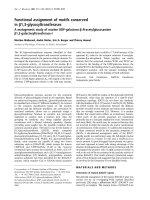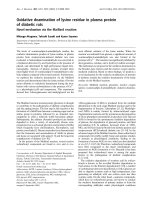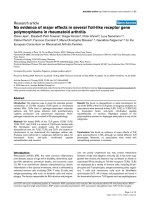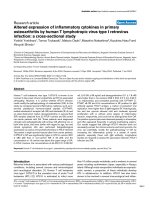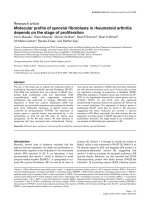Báo cáo y học: "Marked increase of procalcitonin after the administration of anti-thymocyte globulin in patients before hematopoietic stem cell transplantation does not indicate sepsis: a prospective study" pptx
Bạn đang xem bản rút gọn của tài liệu. Xem và tải ngay bản đầy đủ của tài liệu tại đây (224.46 KB, 7 trang )
Open Access
Available online />Page 1 of 7
(page number not for citation purposes)
Vol 13 No 2
Research
Marked increase of procalcitonin after the administration of
anti-thymocyte globulin in patients before hematopoietic stem
cell transplantation does not indicate sepsis: a prospective study
Helena Brodska
1,2
, Tomas Drabek
2,3
, Karin Malickova
1,2
, Antonin Kazda
1,2
, Antonin Vitek
2,4
,
Tomas Zima
1,2
and Marketa Markova
2,4
1
Institute of Clinical Biochemistry and Laboratory Diagnostics, General Teaching Hospital, U nemocnice 2, CZ-128 08 Prague 2, Czech Republic
2
1st Faculty of Medicine, Charles University, Katerinska 32, CZ-121 08 Prague 2, Czech Republic
3
Department of Anesthesiology, Safar Center for Resuscitation Research, University of Pittsburgh, 3434 Fifth Avenue, Pittsburgh, PA 15260, USA
4
Institute of Hematology and Blood Transfusion, U nemocnice 1, CZ-128 20 Prague 2, Czech Republic
Corresponding author: Marketa Markova,
Received: 22 Oct 2008 Revisions requested: 28 Nov 2008 Revisions received: 5 Feb 2009 Accepted: 16 Mar 2009 Published: 16 Mar 2009
Critical Care 2009, 13:R37 (doi:10.1186/cc7749)
This article is online at: />© 2009 Brodska et al.; licensee BioMed Central Ltd.
This is an open access article distributed under the terms of the Creative Commons Attribution License ( />),
which permits unrestricted use, distribution, and reproduction in any medium, provided the original work is properly cited.
Abstract
Introduction Procalcitonin (PCT) and C-reactive protein (CRP)
are established markers of infection in the general population. In
contrast, several studies reported falsely increased PCT levels
in patients receiving T-cell antibodies. We evaluated the validity
of these markers in patients scheduled for hemopoietic stem cell
transplantation receiving anti-thymocyte globulin (ATG) during
conditioning. We also assessed renal and liver functions and
their relationship to PCT and CRP changes.
Methods Twenty-six patients without clinical signs of infection
were prospectively studied. ATG was administered in up to
three doses over the course of 5 days. PCT, CRP, white blood
cell (WBC) count, urea, creatinine, glomerular filtration rate,
bilirubin, alanin amino-transferase (ALT), and gamma-glutamyl
transferase (GGT) were assessed daily during ATG
administration. Pharyngeal, nose, and rectal swabs and urine
samples were cultured twice weekly. Blood cultures were
obtained if clinical symptoms of infection were present.
Results Baseline (BL) levels of both PCT and CRP before ATG
administration were normal. WBC count decreased after ATG
administration (P = 0.005). One day after ATG administration,
both PCT and CRP levels increased significantly, returning to
BL levels on day 4. Microbiological results were clinically
unremarkable. There was no interrelationship between PCT
levels and BL markers of renal or liver functions (P > 0.05 for all
comparisons). Bilirubin and GGT were increased on days 2 to 5
and ALT was increased on day 3 (P < 0.05 versus BL). No
difference in renal functions was observed. Three patients
developed bacterial infection on days 7 to 11 with different
dynamics of PCT and CRP. There was no association between
the number of ATG doses and PCT levels or between the risk of
developing infection and previous PCT levels.
Conclusions ATG triggered a marked early surge in PCT and
CRP followed by a steady decrease over the course of 3 days.
The dynamics of both PCT and CRP were similar and were not
associated with infection. PCT levels were independent of renal
and liver functions and were not predictive of further infectious
complications. A direct effect of ATG on T lymphocytes could be
the underlying mechanism. Hepatotoxic effect could be a
contributing factor. Neither PCT nor CRP is a useful marker that
can identify infection in patients receiving ATG.
Introduction
Patients undergoing allogeneic hematopoietic stem cell trans-
plantation are subjected to substantial immunoalteration that
puts them at increased risk for acquiring infection. Immuno-
suppression during the conditioning phase before engrafting
is induced by pharmacotherapy or total body irradiation. This
results in significantly altered inflammatory response to infec-
tion. Clinical and laboratory markers of sepsis are of limited
ALT: alanin amino-transferase; ATG: anti-thymocyte globulin; BL: baseline; CRP: C-reactive protein; GFR: glomerular filtration rate; GGT: gamma-
glutamyl transferase; IL: interleukin; PCT: procalcitonin; SIRS: systemic inflammatory response syndrome; TNF-: tumor necrosis factor-alpha; WBC:
white blood cell.
Critical Care Vol 13 No 2 Brodska et al.
Page 2 of 7
(page number not for citation purposes)
value. White blood cell (WBC) count is intentionally
decreased and therefore has little informational value. Fever,
another important clinical sign, can be caused by multiple fac-
tors or, by contrast, can be absent. Biochemical markers of
inflammation – C-reactive protein (CRP) and procalcitonin
(PCT) – were shown to be able to reliably diagnose infection
in the general population. PCT seems to be superior in the
early detection of inflammation. It also enables the differentia-
tion between systemic inflammatory response syndrome
(SIRS) and sepsis [1]. PCT concentrations are increased even
in immunocompromised septic patients [2]. In neutropenic
patients, PCT helps to identify those who require antibiotic
treatment [3,4].
Anti-thymocyte globulin (ATG) is frequently used as part of a
conditioning regimen in patients scheduled for allogeneic
hematopoietic stem cell transplantation. In those patients,
freedom from infection before engraftment is of the utmost
importance. ATG administration could be associated with sys-
temic reaction, including fever and hypotension, comparable
to sepsis. The ATG-induced depletion of leukocytes makes
one of the key diagnostic criteria of SIRS/sepsis [5] useless.
Thus, biochemical markers of inflammation could be beneficial
to differentiate between infectious versus non-infectious com-
plications in this specific population. We prospectively evalu-
ated the validity of CRP and PCT to diagnose infection in
patients receiving ATG prior to hematopoietic stem cell trans-
plantation. We also assessed renal and liver functions and
their relationship to PCT and CRP changes.
Materials and methods
In an observational non-randomized study, we prospectively
evaluated a cohort of 26 adult patients indicated for an ATG
conditioning regimen prior to hematopoietic stem cell trans-
plantation. The patients were treated at the Institute of Hema-
tology and Blood Transfusion in Prague, Czech Republic. The
study was approved by the institutional review board. The pur-
pose and procedures of the study were explained to partici-
pants, and written informed consent was obtained.
Interventions
The conditioning regimen was selected according to the
underlying disease. The ATG dose was selected according to
donor-patient matching. A test dose of ATG (20 mg) was
given after the baseline (BL) samples were obtained on day 0.
Afterwards, ATG was administered once daily at a dose of 20
mg/kg during 6-hour infusion, and in those patients who were
indicated for a total dose of 40 mg/kg, 20 mg/kg was admin-
istered the next day. Typically, there were two or three doses
before transplantation.
Blood samples were drawn under aseptic conditions from a
Figure 1
Dynamics of measured parameters during conditioning with anti-thymocyte globulinDynamics of measured parameters during conditioning with anti-thymocyte globulin. Values are presented as mean ± standard deviation. *P < 0.05
versus baseline. ALT, alanin aminotransferase (normal: 0.1 to 0.78 kat/L); BILI, bilirubin (normal: 2 to 17 mol/L); CREAT, creatinine (normal: 44 to
104 mol/L for females and 44 to 110 mol/L for males); CRP, C-reactive protein (normal: <7 mg/L); Dx, day of conditioning regimen (see Results
section for details); GFR, glomerular filtration rate (normal: 1.5 to 2.0 mL/s); GGT, gamma-glutamyl transferase (normal: 0.1 to 0.68 kat/L); PCT,
procalcitonin (normal: < 0.5 g/L); urea (normal: 2.0 to 6.7 mmol/L for females and 2.8 to 8.0 mmol/L for males); WBC, white blood cell (count) (4.3
to 10.8 × 10
9
/L).
Available online />Page 3 of 7
(page number not for citation purposes)
central venous catheter daily until transplantation. Heparinized
plasma was used for PCT, CRP, and renal and liver function
tests. PCT was measured by enzyme-linked fluorescence
immunoabsorbent assay (VIDAS BRAHMS PCT; bioMérieux,
Marcy l'Etoile, France). CRP was measured by turbidimetry
(Modular SWA; Roche, Basel, Switzerland). WBC count was
analyzed from K
3
EDTA (ethylenediaminetetraacetic acid)
samples by a blood count analyzer (Advia 120; Bayer,
Leverkusen, Germany). Turbidimetry (Modular SWA) was also
used for analyses of alanin amino-transferase (ALT), gamma-
glutamyl transferase (GGT), and bilirubin to assess liver func-
tion and of urea, creatinine, and glomerular filtration rate (GFR)
to assess renal function.
Pharyngeal, nose, and rectal swabs and urine samples were
obtained prior to the initiation of treatment and twice weekly
afterwards. Same samples plus blood cultures were obtained
from all lumens of the central venous catheters and a periph-
eral vein when body temperature (measured in the axilla)
increased above 37.5°C. Blood cultures were cultivated for
both aerobic and anaerobic bacteria and for fungi (bacT/
ALERT; bioMérieux).
Statistical analysis
The plasma concentrations of biochemical markers are
reported as mean ± standard deviation unless noted other-
wise. Given a non-parametric distribution of results, concen-
trations of markers were compared using the Kruskal-Wallis
test. Correlations between levels of markers were examined
with the Spearman rank correlation coefficient. PCT levels
were analyzed and categorized into quartiles according to a
concentration to evaluate their association with the post-ATG
febrile/infectious complications. All statistical analyses were
performed using Statistica CZ 8.0 software (StatSoft Inc.,
Tulsa, OK, USA). All tests were two-tailed, and P values of less
than 0.05 were considered statistically significant.
Results
The demographic data and patients' characteristics are pre-
sented in Table 1. A significant increase in PCT was observed
starting 24 hours after ATG administration. The initial surge
was followed by a slow steady decrease. On day 5, PCT levels
were still increased, but there was no statistical difference ver-
sus BL levels. The dynamics of CRP changes were similar to
PCT, but CRP returned to BL values 1 day earlier. Similar sta-
tistically significant trends were observed for bilirubin and
GGT. In contrast, ALT increased only transiently on day 2.
There were no changes in urea, creatinine, or GFR during con-
ditioning. Progressive depletion of leukocytes was observed
over time (Figure 1). There was no statistically significant inter-
relationship of PCT levels and markers of renal or liver func-
tions (P < 0.05 for all comparisons) (Table 2).
The relative odds of post-ATG febrile complications did not
increase significantly with each increasing quartile of BL PCT
concentration. Thus, patients in the highest versus lowest
quartile did not have any increase in risk. After adjustment for
CRP, the concentration of PCT remained unassociated with
the risk of post-ATG febrile complications (Table 3). There was
no relationship between the number of ATG doses and PCT
concentrations (P = 0.16) (Figure 2). Microbiological cultures
of the pharyngeal, nose, and rectal swabs and urine samples
yielded clinically insignificant results. Blood cultures obtained
during conditioning did not grow any bacteria or fungi over the
course of the 7-day inoculation period. Three patients devel-
oped sepsis 7 to 11 days after the ATG conditioning. The
changes in PCT and CRP were different from those observed
during conditioning (Table 4).
Discussion
Both PCT and CRP have been shown to successfully diag-
nose systemic inflammation in various patient populations. A
recent review of the role of PCT in febrile neutropenic patients
suggested the superior role of PCT over other markers of
Table 1
Basic descriptive characteristics of patients
Characteristic Number (percentage) of patients
a
Gender
Males 14 (54%)
Females 12 (46%)
Diagnosis
Acute lymphoblastic leukemia 4 (17%)
Acute myeloid leukemia 7 (29%)
Myeloproliferative syndrome 5 (17%)
Chronic lymphatic leukemia 2 (8%)
Chronic myeloid leukemia 1 (4%)
Myelodysplastic syndrome 4 (13%)
Non-Hodgkin lymphoma 2 (8%)
Hodgkin disease 1 (4%)
Age at ATG treatment, years
Mean (minimum, maximum) 43 (24, 62)
Number of ATG doses
Two 11 (42%)
Three 12 (46%)
Four 3 (12%)
Post-ATG body temperature
Normal body temperature 20 (77%)
Body temperature <37.5°C 5 (20%)
Body temperature >37.5°C 1 (3%)
a
Values are presented as number (percentage) of patients, except for
those of 'Age at ATG treatment', which are presented as mean
(minimum, maximum). ATG, anti-thymocyte globulin.
Critical Care Vol 13 No 2 Brodska et al.
Page 4 of 7
(page number not for citation purposes)
infection in this population. Patients undergoing conditioning
before hematopoietic stem cell transplantation represent a
distinct population with significantly altered immune response.
This creates a challenging scenario for clinical diagnosis of
incipient infection which could be potentially catastrophic if
not discovered early. Conditioning with ATG, a heterogeneous
protein, can be associated with adverse reactions, mainly cir-
culatory instability and/or respiratory insufficiency. The severity
of this reaction could be highly individual and in selected
cases could closely resemble sepsis. Ancillary biochemical
tests that would readily detect infection would be of great
benefit.
In our cohort of patients undergoing conditioning with ATG,
we observed a characteristic early surge in PCT and CRP, fol-
lowed by a steady decline to a near-normalization on day 4. Yet
this was not associated with clinical infection, as monitored by
microbiological cultures. Thus, neither PCT nor CRP proved
useful as a valid complementary diagnostic tool in this setting.
Our observation has some support in the literature. Several
previous reports suggested limited diagnostic value of PCT
and CRP in the presence of anti-T-lymphocyte antibodies. In
kidney transplant patients receiving pan-T-cell antibodies,
Sabat and colleagues [6] found increased PCT concentra-
tions that were comparable to those observed in sepsis. Sim-
Table 2
Interrelationship of procalcitonin and other measured laboratory parameters
Procalcitonin
r Baseline Day 1 Day 2 Day 3 Day 4 Day 5
Baseline values of
CRP 0.04 0.17 0.06 0.29 0.32 0.03
BILI 0.04 0.35 0.23 0.09 0.21 0.13
GGT 0.03 0.22 0.07 0.22 0.19 0.02
ALT 0.10 0.14 0.17 0.07 0.21 0.07
GFR 0.12 0.32 0.08 0.04 0.09 0.16
Urea 0.11 0.22 0.31 0.25 0.43 0.19
CREAT 0.25 0.18 0.24 0.21 0.32 0.17
All measured significance levels are greater than 5% (n = 26, Spearman rank correlation test, r). Baseline = initial/pretreatment value. ALT, alanin
aminotransferase; BILI, bilirubin; CREAT, creatinine; CRP, C-reactive protein; GFR, glomerular filtration rate; GGT, gamma-glutamyl transferase.
Figure 2
The relationship between the number of anti-thymocyte globulin (ATG) doses and procalcitonin (PCT) valuesThe relationship between the number of anti-thymocyte globulin (ATG) doses and procalcitonin (PCT) values. Black square markers represent the
mean, boxes represent standard deviation, and whiskers represent the minimum/maximum for each group. P = 0.16 between groups.
Available online />Page 5 of 7
(page number not for citation purposes)
ilarly to our results, the early surge was observed 24 hours
after the initiation of treatment. The increase in tumor necrosis
factor-alpha (TNF-) preceded the increase in PCT and was
detectable as early as a few minutes after ATG administration.
However, those patients did not have any infection [6]. Simi-
larly, Zazula and colleagues [7] found increased PCT levels in
orthotopic liver transplant recipients on the first day after sur-
gery, with a more marked increase in those who received ATG.
PCT decreased independently of further ATG administration
in both groups of patients. No evidence of infection was
present in either group [7].
Dornbusch and colleagues [8], in a small retrospective study,
evaluated the diagnostic value of PCT and CRP in differentiat-
ing sepsis and febrile reaction after administration of anti-T-
lymphocyte antibodies in pediatric patients. Neither PCT peak
levels nor PCT concentrations 3 days after the onset of febrile
reactions differed between septic patients and those receiving
T-cell antibodies. Both PCT and CRP showed a trend similar
to our observation, except for 5 (out of 21) patients whose
CRP remained increased for 20 days irrespective of the dura-
tion of T-cell antibody administration [8].
Pihusch and colleagues [9] prospectively studied PCT, CRP,
and interleukin-6 (IL-6) in 350 stem cell recipients. Condition-
ing with ATG increased all monitored markers. In neutropenic
patients receiving ATG, there was no difference in PCT levels
between patients with or without infections. After engraftment,
PCT levels in patients without infections were significantly
lower than in patients with infectious complications. However,
the initial increase was less pronounced than in our cohort but
persisted longer [9].
ATG is a mixture of antibodies against T cells with direct effect.
The binding location of ATG on lymphocytes is mainly CD2,
CD3, CD4/CD28, CD7
+
, LFA-1
+
, and ICAM-1, receptors
characteristic for T cells. The main mechanism of action is
opsonization and lysis by complement activation, leading to T-
cell depletion.
The evidence suggests that the increase in PCT and CRP is
not restricted to ATG. Similar reactions were observed after
treatment with other T-cell antibodies, namely OKT-3. Treat-
ment with monoclonal CD52 antibody alemtuzumab triggered
even higher levels of PCT and CRP, comparable to Gram-neg-
ative sepsis [10].
The exact function, mechanism, and site of PCT production
have yet to be fully unveiled. PCT activity has been identified
in human leukocytes [11]. Others have suggested that liver
[12,13], lungs, neuroendocrine cells, or various other tissues
are possible sites of production [14,15].
A profound stimulatory effect of TNF- on PCT mRNA levels
[11] or PCT itself was observed. After TNF- administration,
PCT reached half-maximal concentrations within 8 to 12 hours
earlier than CRP. It was suggested that PCT and acute-phase
proteins such as CRP are induced by similar pathways [12]. It
could be hypothesized that the T-cell antibody-induced
increase of PCT is mediated via release of TNF- and does not
represent a direct effect of the antibody [16].
In our study, induction of PCT increase by ATG administration
can be explained mainly by lymphocyte destruction. However,
the contribution of hepatotoxicity must also be considered. As
the dynamics of PCT and CRP changes are similar, we do not
Table 3
Relative odds of post-anti-thymocyte globulin febrile complications according to procalcitonin concentration on transplantation
day
Quartile of procalcitonin concentration
(range, g/L)
Q1
(<1.6)
Q2
(1.6–4.1)
Q3
(4.1–14.9)
Q4
(>183)
P trend
Crude matched pairs
OR 1.00 1.10 1.05 1.10 0.095
95% CI - 0.03–0.85 0.25–5.87 2.51–59.87
P value - 0.26 0.11 0.09
Adjusted for C-reactive protein
OR 1.0 1.08 1.10 1.07 0.123
95% CI - 0.026–0.99 0.31–5.75 2.41–58.35
P value - 0.34 0.10 0.09
The relative odds of post-anti-thymocyte globulin (ATG) febrile/infectious complications did not increase significantly with each increasing quartile
of baseline procalcitonin concentration, so patients in the highest versus lowest quartile did not have any increase in risk. After adjustment for C-
reactive protein, the concentration of procalcitonin remained unassociated with the risk of post-ATG febrile complications. CI, confidence interval;
OR, odds ratio.
Critical Care Vol 13 No 2 Brodska et al.
Page 6 of 7
(page number not for citation purposes)
believe that a difference in half-time of these parameters plays
a role here [17].
Bacterial infection with positive blood cultures developed in
three patients in our study on days 7 to 11 after the last ATG
dose. The dynamics of PCT and CRP changes in those
patients during this episode were different from the character-
istic course of ATG-induced changes and were not associated
with actual WBC count.
Understanding the mechanisms of PCT release could help to
elucidate its increase in other non-infectious conditions, as
described below. The extent of this increase in our cohort was
not dependent on initial liver and renal functions or WBC
count. It was not predictive within the context of subsequent
infectious complications and/or mortality. It could be specu-
lated that the extent of PCT increase is related to a certain
immunological body reserve that may not be fully reflected by
actual WBC count or, more specifically, by transition of mono-
cytes into macrophages.
A variety of clinical conditions, including cardiac surgery [18]
and heatstroke [19], with increased PCT of non-infectious
causes were reported. In healthy term neonates, a transient
increase in PCT peaking at 24 hours after birth and gradually
decreasing over the first 48 hours of life was observed [20]. In
chronic renal insufficiency patients, results are conflicting. In
pediatric patients, a small increase in BL PCT levels was
observed [21]. Adult patients undergoing chronic hemodialy-
sis treatment had normal PCT levels. In contrast, CRP was
markedly increased in patients undergoing short- and long-
term hemodialysis. PCT, but not CRP, was increased in
patients on peritoneal dialysis [22]. An isolated increase in
PCT, but not CRP or other inflammatory parameters, was reg-
istered in patients with medullar thyroid carcinoma [23,24].
Our study has limitations. We did not assess other markers
(for example, IL-6, IL-8, TNF-, endotoxin, serum amyloid A, or
neopterin) that could be considered to augment the diagnosis
of infection in neutropenic patients, as explored by others [25].
Also, we did not study any patients who would acquire infec-
tion during ATG conditioning and would represent a control
group. This situation is extremely rare and only a few cases
have been reported [9]. Based on our results and the available
literature, we are not able to recommend any single test that
would be able to rule in an infection in this specific patient pop-
ulation. A combination of a detailed clinical assessment and
careful interpretation of collateral biochemical and microbio-
logical tests probably remains to be the optimal approach tar-
geted to individual patients. The mechanism of inflammatory
reaction in neutropenic patients and prompt detection of infec-
tion in those patients need to be explored in future studies.
Conclusions
ATG administration was associated with a characteristic rapid
surge in both PCT and CRP followed by a steady decline over
the next 3 days. This increase was not associated with sys-
temic infection. The number of ATG doses was not related to
the peak PCT concentrations. ATG induced an increase in
liver function tests but not in markers of renal function. PCT
levels were not altered by renal and liver functions or WBC
count before conditioning. PCT seems to have no predictive
value of future infectious complications. Both PCT and CRP
have limited value in the diagnosis of infection during the
administration of ATG.
Competing interests
The authors declare that they have no competing interests.
Authors' contributions
HB carried out the laboratory work and drafted the manuscript.
MM was responsible for the patient care, ATG administration,
sample timing, and collection and contributed to the prepara-
tion of the manuscript. KM performed the statistical analysis.
AV participated in the transplantation and contributed to the
study design. AK and TZ participated in the study design and
helped to draft the manuscript. TD intellectually contributed to
the preparation of the manuscript. All authors read and
approved the final manuscript.
Acknowledgements
This project was supported by the research project 0021620807 of the
Czech Ministry of Education and by the Scientific Program of the Czech
Ministry of Health (00023736).
Table 4
Procalcitonin and C-reactive protein concentrations and white
blood cell count in patients with delayed sepsis
Patient 1 D11 D12 D13 D14 D15
PCT, g/L 1.713.4584336
CRP, mg/L 124 150 173 295 300
WBC × 10
9
/L 0.12 0.23 0.35 0.50 0.48
Patient 2 D7D8D9D10D11
PCT, g/L 7 8.1 5.3 3.1 1.1
CRP, mg/L 304 311 201 182 110
WBC × 10
9
/L 0.03 0.03 0.03 - 0.02
Patient 3 D8 D9 D10 D11 D12
PCT, g/L 8.3 5.4 3.2 1.8 1.1
CRP, mg/L 270 330 370 260 180
WBC × 10
9
/L 0.18 0.22 0.15 0.12 0.10
The dynamics of markers of procalcitonin (PCT) and C-reactive
protein (CRP) in patients who developed delayed sepsis on days 7
to 11 after conditioning with anti-thymocyte globulin (ATG) were
different from the dynamics of increase in PCT and CRP that were
observed during ATG conditioning. Dx, days after conditioning;
WBC, white blood cell.
Available online />Page 7 of 7
(page number not for citation purposes)
References
1. Castelli GP, Pognani C, Meisner M, Stuani A, Bellomi D, Sgarbi L:
Procalcitonin and C-reactive protein during systemic inflam-
matory response syndrome, sepsis and organ dysfunction.
Crit Care 2004, 8:R234-242.
2. Giamarellou H, Giamarellos-Bourboulis EJ, Repoussis P, Galani L,
Anagnostopoulos N, Grecka P, Lubos D, Aoun M, Athanassiou K,
Bouza E, Devigili E, Krcmery V, Menichetti F, Panaretou E, Papa-
georgiou E, Plachouras D: Potential use of procalcitonin as a
diagnostic criterion in febrile neutropenia: experience from a
multicentre study. Clin Microbiol Infect 2004, 10:628-633.
3. Robinson JO, Calandra T, Marchetti O: [Utility of procalcitonin
for the diagnosis and the follow-up of infections in febrile neu-
tropenic patients]. Rev Med Suisse 2005, 1:878-882.
4. Jimeno A, García-Velasco A, del Val O, González-Billalabeitia E,
Hernando S, Hernández R, Sánchez-Muñoz A, López-Martín A,
Durán I, Robles L, Cortés-Funes H, Paz-Ares L: Assessment of
procalcitonin as a diagnostic and prognostic marker in
patients with solid tumors and febrile neutropenia. Cancer
2004, 100:2462-2469.
5. American College of Chest Physicians/Society of Critical Care
Medicine Consensus Conference: definitions for sepsis and
organ failure and guidelines for the use of innovative thera-
pies in sepsis. Crit Care Med 1992, 20:864-874.
6. Sabat R, Hoflich C, Docke WD, Oppert M, Kern F, Windrich B,
Rosenberger C, Kaden J, Volk HD, Reinke P: Massive elevation
of procalcitonin plasma levels in the absence of infection in
kidney transplant patients treated with pan-T-cell antibodies.
Intensive Care Med 2001, 27:987-991.
7. Zazula R, Prucha M, Tyll T, Kieslichova E: Induction of procalci-
tonin in liver transplant patients treated with anti-thymocyte
globulin. Crit Care 2007, 11:R131.
8. Dornbusch HJ, Strenger V, Kerbl R, Lackner H, Schwinger W,
Sovinz P, Urban C: Procalcitonin and C-reactive protein do not
discriminate between febrile reaction to anti-T-lymphocyte
antibodies and Gram-negative sepsis. Bone Marrow Transplant
2003, 32:941-945.
9. Pihusch M, Pihusch R, Fraunberger P, Pihusch V, Andreesen R,
Kolb HJ, Holler E: Evaluation of C-reactive protein, interleukin-
6, and procalcitonin levels in allogeneic hematopoietic stem
cell recipients. Eur J Haematol 2006, 76:93-101.
10. Dornbusch HJ, Strenger V, Sovinz P, Lackner H, Schwinger W,
Kerbl R, Urban C:
Non-infectious causes of elevated procalci-
tonin and C-reactive protein serum levels in pediatric patients
with hematologic and oncologic disorders. Support Care
Cancer 2008, 16:1035-1040.
11. Oberhoffer M, Stonans I, Russwurm S, Stonane E, Vogelsang H,
Junker U, Jager L, Reinhart K: Procalcitonin expression in human
peripheral blood mononuclear cells and its modulation by
lipopolysaccharides and sepsis-related cytokines in vitro . J
Lab Clin Med 1999, 134:49-55.
12. Nijsten MW, Olinga P, The TH, de Vries EG, Koops HS, Groothuis
GM, Limburg PC, ten Duis HJ, Moshage H, Hoekstra HJ, Bijzet J,
Zwaveling JH: Procalcitonin behaves as a fast responding
acute phase protein in vivo and in vitro. Crit Care Med 2000,
28:458-461.
13. Kretzschmar M, Kruger A, Schirrmeister W: Procalcitonin follow-
ing elective partial liver resection – origin from the liver? Acta
Anaesthesiol Scand 2001, 45:1162-1167.
14. Snider RH Jr, Nylen ES, Becker KL: Procalcitonin and its compo-
nent peptides in systemic inflammation: immunochemical
characterization. J Investig Med 1997, 45:552-560.
15. Russwurm S, Stonans I, Stonane E, Wiederhold M, Luber A, Zipfel
PF, Deigner HP, Reinhart K: Procalcitonin and CGRP-1 mrna
expression in various human tissues. Shock 2001,
16:109-112.
16. Kuse ER, Jaeger K: Procalcitonin increase after anti-CD3 mon-
oclonal antibody therapy does not indicate infectious disease.
Transpl Int 2001, 14:55.
17. Brunkhorst FM, Heinz U, Forycki ZF: Kinetics of procalcitonin in
iatrogenic sepsis. Intensive Care Med 1998, 24:888-889.
18. Sponholz C, Sakr Y, Reinhart K, Brunkhorst F: Diagnostic value
and prognostic implications of serum procalcitonin after car-
diac surgery: a systematic review of the literature. Crit Care
2006, 10:R145.
19. Nylen ES, Al Arifi A, Becker KL, Snider RH Jr, Alzeer A: Effect of
classic heatstroke on serum procalcitonin. Crit Care Med
1997,
25:1362-1365.
20. Assumma M, Signore F, Pacifico L, Rossi N, Osborn JF, Chiesa C:
Serum procalcitonin concentrations in term delivering moth-
ers and their healthy offspring: a longitudinal study. Clin Chem
2000, 46:1583-1587.
21. Lorton F, Veinberg F, Ielsch D, Deschenes G, Bensman A, Ulinski
T: Procalcitonin serum levels in children undergoing chronic
haemodialysis. Pediatr Nephrol 2007, 22:430-435.
22. Steinbach G, Bolke E, Grunert A, Storck M, Orth K: Procalcitonin
in patients with acute and chronic renal insufficiency. Wien
Klin Wochenschr 2004, 116:849-853.
23. Bolko P, Manuszewska-Jopek E, Michalek K, Wasko R, Jaskula M,
Sowinski J: Efficacy of procalcitonin measurement in patients
after total thyroidectomy due to medullary thyroid carcinoma.
Arch Immunol Ther Exp (Warsz) 2003, 51:415-419.
24. Ittner L, Born W, Rau B, Steinbach G, Fischer JA: Circulating pro-
calcitonin and cleavage products in septicaemia compared
with medullary thyroid carcinoma. Eur J Endocrinol 2002,
147:727-731.
25. Prat C, Sancho JM, Dominguez J, Xicoy B, Gimenez M, Ferra C,
Blanco S, Lacoma A, Ribera JM, Ausina V: Evaluation of procal-
citonin, neopterin, C-reactive protein, IL-6 and IL-8 as a diag-
nostic marker of infection in patients with febrile neutropenia.
Leuk Lymphoma 2008, 49:1752-1761.
Key messages
• Anti-thymocyte globulin (ATG) administered during con-
ditioning before hematopoietic stem cell transplantation
triggered a marked increase in both procalcitonin (PCT)
and C-reactive protein (CRP) with a peak at 24 hours
after administration, followed by a steady decline over
the next 3 days. This increase was not associated with
systemic infection.
• The number of ATG doses was not related to the peak
PCT concentrations.
• ATG induced an increase in liver function tests but not
in markers of renal function. PCT levels were not altered
by renal and liver functions or white blood cell count
before conditioning.
• PCT seems to have no predictive value of future infec-
tious complications.
• Both PCT and CRP have limited value in the diagnosis
of infection during administration of ATG.
